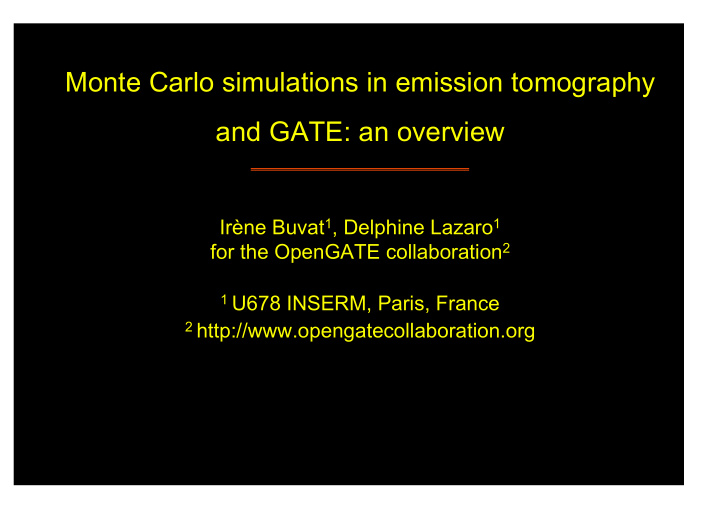



Monte Carlo simulations in emission tomography and GATE: an overview Irène Buvat 1 , Delphine Lazaro 1 for the OpenGATE collaboration 2 1 U678 INSERM, Paris, France 2 http://www.opengatecollaboration.org
Outline • Evolution of the use of MC simulations in ET since 1995 • Evolution of the codes used for MC simulations in ET since 1995 • New features in MC simulators in ET • New applications for MC simulations • Upcoming developments in MC simulations • Conclusion
Evolution of the use of MC simulations in ET since 1995 Important role in SPECT and PET, for optimizing detector design, designing and assessing acquisition and processing protocols. • Zaidi, Relevance of accurate Monte Carlo modeling in nuclear medical imaging. Med Phys 26 (1999) 574-608 • Buvat and Castiglioni, Monte Carlo simulations in SPET and PET. Q J Nucl Med 46 (2002) 48-61
Evolution of the use of MC simulations in ET since 1995 • 666 entries since 1995 at the date of the search (July 1995) • Use of MC simulations to produce SPECT and PET images: 130 entries 86% SPECT 65% SPECT 14% PET 35% PET 0 small animal 5 small animal Number of full papers 20 10 0 1994 1996 1998 2000 2002 2004 2006 Year 28 labs 33 labs
Evolution of the codes used for MC simulations in ET since 1995 1995-1999 2000-2004 • 14 different codes: • 15 different codes: - 10 « home-made » - 8 « home-made » - 4 publicly released or available - 7 publicly released or available from authors from authors No « standard » code for Monte Carlo simulations in SPECT and PET And recently Most frequently used Penelope SimSET SIMIND GATE
Most recent code: GATE • Motivation in 2001: provide a public code - based on a standard code to ensure reliability - enabling SPECT and PET simulations (possibly even more) - accommodating almost any detector design (including prototypes) - modeling time-dependent processes - user-friendly • Developed by the OpenGATE collaboration (21 labs) • Based on GEANT4 • Publicly released May 2004: http://www.opengatecollaboration.org • More than 400 subscribers to the Gate users mailing list • IEEE MIC 2004: 61 proceedings involving MC simulations in SPECT and PET 11 used GATE, 9 used GEANT4, 8 used SimSET, 4 used SIMIND
Monte Carlo simulations today
Modeling time dependent processes Possible using SORTEO, SimSET and GATE No TOF Reilhac et al, IEEE TNS 2005 700 ps Harrison et al, IEEE MIC Conf Rec 2004 15 O (2 min) 11 C (20 min) 500 ps Santin et al, IEEE TNS 2003 300 ps Groiselle et al, IEEE MIC Conf Rec 2004
Increasing the throughput of the simulations Using acceleration methods Parallel execution of the code • Variance reduction techniques such as importance sampling (e.g. in SimSET) speed-up factors between 2 and 15 • Fictitious cross-section (or delta scattering) Combining MC and non MC modeling Full MC ARF Thomason et al, Comp Methods Song et al, Phys Med Biol 2005 Programs Biomed 2004 increase in efficiency > 100
Modeling original detector designs Non-conventional geometries Prototypes shielding collimator PSPMT crystal TEP/CT BIOGRAPH Siemens IASA CsI(Tl) gamma camera detection Energy spectrum block GATE Number of counts Experiment Experiment lead end-shielding Spherical geometry of the Hi-Rez PET scanner Lazaro et al, SNM 2005 Energy (keV) GATE Lazaro et al, Phys Med Biol 2004
New applications for Monte Carlo simulations 1995-1999 2000-2004 Design and assessment of correction and reconstruction methods Study of an imaging system response Use in the very imaging process Data production for evaluation purpose Description and validation of a code
Using Monte Carlo simulations for calculating the system matrix “Object” f Projection p p = R f i j R(i,j): probability that a photon emitted in voxel j be detected in pixel i Calculating R using Monte Carlo simulations: • for non conventional imaging design (small animal) • to account for fully 3D and patient-specific phenomena difficult to model analytically (mostly scatter) e.g., Lazaro et al Phys Med Biol 2005, Rafecas et al IEEE TNS 2004, Rannou et al IEEE MIC Conf Rec 2004
Using Monte Carlo for feeding database http://www.ibfm.cnr.it/mcet/index.html http://sorteo.cermep.fr Reilhac et al, IEEE TNS 2005 Castiglioni et al, Eur J Nucl Med Mol Imaging 2005
What next?
Bridging the gap between MC modelling in imaging and dosimetry Accurate dosimetry in 131I radionuclide therapy using patient-specific, 3-dimensional methods for SPECT reconstruction and absorbed dose calculation GATE SIMIND DPM GATE DPM GATE Dewaraja et al, J Nucl Med 2005
Modeling hybrid machines (PET/CT, SPECT/CT, OPET) PET/CT SPECT/CT OPET GATE GATE GATE TOAST Alexandrakis et al, Phys Med Brasse et al, IEEE MIC Conf Biol 2005 Rec 2004 Integrating Monte Carlo modeling tools for: - common coordinate system - common object description - consistent sampling - convenient assessment of multimodality imaging
Designing realistic phantoms Interfacing realistic phantoms with simulator input NCAT MOBY Segars et al, IEEE TNS 2001 Segars et al, Mol Imaging Biol 2004 Making it easier to model a wide range of body habitus and physiological motions
Conclusion • Monte Carlo simulation is a more and more accurate modelling tool in SPECT and PET • They will be more and more present in (nuclear) medical imaging in the future: - as a invaluable guide for designing imaging protocols and interpreting SPECT and PET scans, - in the very imaging process of a patient
Acknowledgments the OpenGATE collaboration Isabella Castiglioni Chicca Gilardi Robert Harrison Anthonin Reilhac
Recommend
More recommend